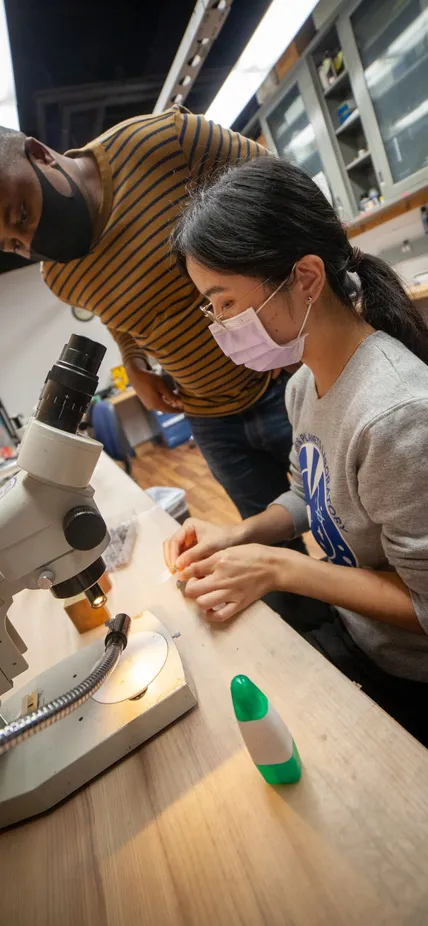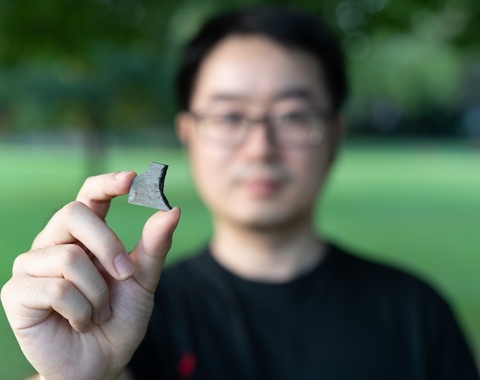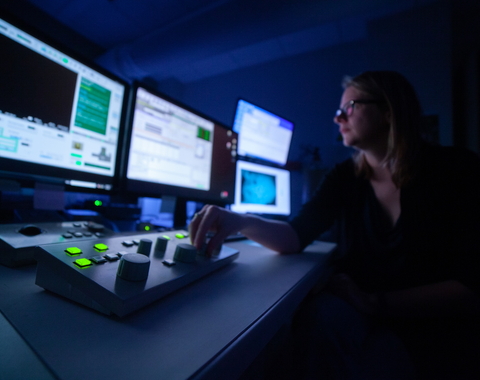The top-tier instrumentation at Carnegie’s Earth and Planets Laboratory (EPL) makes it one of the best places in the world to study materials under pressure. Jill Yang is the high-pressure research technician in charge of making sure those machines work according to plan—and she takes her job seriously!
Yang has worked at Carnegie for the past four years, first as a postdoctoral fellow and more recently as a research technician. In her new role, she uses the extremely specialized set of skills she honed during her fellowship to maintain the instrumentation and labs that allow Carnegie scientists to stay at the forefront of high-pressure materials science. She also trains incoming postdocs on how to use the equipment and helps them navigate the various machines available to them at EPL.
In this interview, Yang discusses her current role and how she first got into high-pressure science.

Who are you and how long have you been at Carnegie?
I am Jing Yang, I prefer to be called Jill at work. I have been at Carnegie for more than 4 years. I first came here as a postdoctoral fellow in 2017 working with Dr. Yingwei Fei on topics related to Earth’s core and then became a research technician at Earth and Planet Laboratory in 2019. Before I came to Carnegie, I did my Ph.D. in mineral physics at The University of Texas at Austin. I was born in Wuhan and studied in Beijing. I love both cities very much.
What do you do at Carnegie and who does it impact?
As trained as a high-pressure scientist, I provide specialist lab support for the high-pressure and high-temperature facilities including the one-atmosphere furnace, piston-cylinder, multi-anvil press, diamond anvil cell, and gas loader. I also train postdoctoral fellows to use the facilities and provide safety support for the labs.
I am working to support the research activities of the staff scientist, research scientists, and postdoctoral fellows.
What is a project that you've worked on that you're proud of?
Last year, I was involved in our own postdoc fellow, Dr. Raj Dutta’s project to study the high pressure and temperature structural changes of magnesium germinate (Mg2GeO4)—a super-Earth mantle analog material.
I helped with loading a diamond anvil cell which we compressed to 275 GPa and heated up homogeneously to 2000 K using lasers. With such a high pressure and temperature we achieved, we broke the record of the experimental station of HPCAT at Advanced Photon Sources of Argonne National Lab!
The experiment led to an exciting discovery that can be applied for the interior mineralogy of large, rocky extrasolar planets. I feel like my experimental skill is unique and helpful to achieve great scientific goals, which made me feel proud of myself.
What is the biggest challenge in your job?
One of the biggest challenges in my job is to keep our platform up-to-date so that we can focus on the cutting-edge problems in high P-T science. As a research technician in high-pressure science, my dream is to develop the most advanced facilities allowing scientists to test their most bold ideas that lead to a fundamental understanding of our planet and the solar system. To keep up my pace, when I am not in the lab, I read newly published papers that are in the high-profile journals related to geophysics, geochemistry, and mineral physics. I also work with other technicians in the design and development of new high pressure and temperature techniques.
Another challenge is working with a diverse group of people that come from different countries, with different cultures and personalities. Because we are in a collaborative environment, I think the best way for me to learn is to thrive on finding the best in my colleagues. That said, sometimes I feel embarrassed if I have difficulties making myself understood due to my somewhat introverted personality.

What inspired you to work in high-pressure science?
I was fortunate to have an excellent advisor when I was doing my undergraduate thesis. She introduced me to the idea of studying the chemical and physical properties of the Earth’s material using various advanced analytical methods, including electron probe, FTIR, and Raman spectroscopy. Her mentorship was extremely impactful and broadened my scientific horizons when I was only 18-year-old.
I discovered my interest in doing high-pressure experiments when I pursued my master’s degree with another excellent advisor at Peking University. He introduced me to the diamond anvil cell technique that can be used to study the chemical and physical properties of materials in the deep Earth interior.
I carried out high-pressure experiments combined with analytical methods that I was already familiar with to study Earth’s deep interior. He also introduced me to the synchrotron facilities in both Beijing and Japan. The giant and extremely complicated facilities there astonished me and made me feel like I was a “real scientist” who could do the coolest scientific research. Two years of experience at Peking University completely changed my career path and led me to pursue a Ph.D. in high-pressure Earth science in the US.
How has your background influenced your work as a scientist?
My parents were very supportive of my education, although they have not got access to higher education. I remember when I was a kid, they took me to the bookstores and bought me whatever books that I was interested in, even when they sometimes could barely afford those books, and they have two children to raise.
Growing up, they would do everything they could do to send me to better schools to be exposed to a good environment and gain a better education. In my childhood, they respected my choices and let me decide what was best for me. I think the way my parents raised me allowed me to always trust myself in decision-making and keep the initiative in my own hands. In my mind, a scientist is independent and is always thinking critically. That is how I discipline myself.
On the other hand, my parents’ approach let me realize the importance of education—as they always made education a top priority. I choose to stay in the field of scientific research because I can constantly learn and educate people by doing research and advancing knowledge.
Why did you choose to work at the Earth and Planets Laboratory?
I first came here as a postdoctoral fellow at Geophysical Laboratory before GL and DTM merged to Earth’s and Planets Laboratory. I directly applied for a position here as this is the best place in the field of high-pressure science.
Most of my admired Earth’s science professors at UT and other universities spent multiple years at Carnegie in their early career years and I got to hear about the excellent experiences they had at Carnegie. I was very fortunate to be offered the opportunity to work with Dr. Yingwei Fei on various projects in 2017-2019. In his lab, I gained training on various new high-pressure techniques, including the multi-anvil press and piston-cylinder in addition to the diamond anvil cells.

In 2019, I got the chance to stay at Carnegie as a supporting technician staff thanks to Dr. Yingwei Fei’s comprehensive training on the high-pressure technique during my postdoctoral years. I decided to stay as a permanent family member as I know this is the place I like due to the people, the environment, and the work-life balance.
Working at Carnegie, the most fascinating thing is the opportunities to interact with many brilliant staff scientists and postdocs and participate in a variety of projects to solve a broad range of science questions that I have never thought about.
I am learning and growing every day.
Are you looking forward to anything? Any big projects or updates?
We’re getting a new glovebox! We are allocated a budget to purchase a new glove box from Mbraun which will replace the mal-functional old glove box in the chemistry lab. The glove box will be used for storing and dealing with air-sensitive materials. It will be installed with a new microscope that also allows for delicate diamond anvil cell and multi-anvil cell loadings. I am looking forward to this new addition on campus.
Besides that, there will be multiple upgrades for the multi-anvil lab. We will upgrade the control systems for operating the presses with a more user-friendly interface and software. We will also install a new cubic press in the lab which will initiate many new research projects. In addition, this facility will allow us to synthesize new materials with large enough volume under high pressure and temperature conditions to be used in other research or industry.
When you're not actively researching, do you have any hobbies?
I am obsessed with reading books related to psychology recently. It changed how I think about myself and others. It inspired me to gain inner energy to work and live better. I’ve finished over 40 books in 10 months. Besides reading, I like hiking and traveling. Billy Goat Trail at Great Falls is my favorite trail locally.
I left my footprint in over 20 national parks, and Grand Teton is my favorite so far!
What is one thing you want people on campus to know about your job?
Part of my job is managing the campus’s high-pressure facilities. EPL’s Communications Coordinator Katy Cain and I put together a suite of web pages on the EPL internal website that contains a lot of useful information about these facilities including diagrams and safety information.
If you are interested in these facilities, please check the website link here. (Please note, you will need a Carnegie email address to access these pages.)



